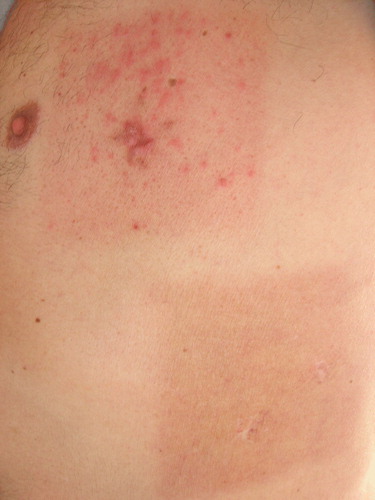To the Editor
A 71-year-old man was treated for a left pleural epitheloid malignant mesothelioma in August 2005. The tumour was found unresectable during thoracoscopy and was staged as pT4N1M0 disease. Following pleurodesis, radiation therapy to the thoracoscopy and drainage tracks was delivered with 21 Gy in three fractions of 7 Gy via a lateral field (orthovoltage therapy). The patient developed transient mild erythema over the treated area. Five days later, pemetrexed chemotherapy (500 mg/m2 iv day 1 every 21 days) was instituted with prophylactic corticotherapy and Vitamin B12 and folic acid supplementation. Following the second course, 41 days after the end of radiotherapy, the patient was noted to have a confluent erythematous macular rash limited within the previously irradiated skin area. The dermatitis resolved in one week with local corticotherapy, without recurrence during the following last 4 cycles of pemetrexed. In August 2006, due to progressive disease and worsening respiratory symptoms after a partial remission, the patient underwent a second pleurodesis. A new course of chest wall radiation therapy to the thoracoscopy and drainage tracks was delivered, 21 Gy in three fractions of 7 Gy with x-rays (160 kV). Six cycles of pemetrexed (400 mg/m2 iv day 1 repeated every 3 weeks) from September 2006 to January 2007 were delivered. Three weeks after the first dose, 26 days after the end of last radiotherapy, he developed a tender erythematous rash in the recently irradiated area. No recurrence was seen in the area exposed previously to radiotherapy (). With local corticotherapy, resolution was obtained in 10 days without further recurrence.
Discussion
Radiation recall is an inflammatory reaction at a previously quiescent irradiated field occurring after drug administration. It was first related in 1958 with actinomycin D Citation[1]. This reaction has been described with cytotoxic chemotherapy such as antimetabolites, taxanes, anthracyclines and alkylating agents Citation[2], Citation[3]. Other drugs including tamoxifen, simavastin, antibiotics, and exposure to ultraviolet light Citation[2], Citation[3] have also been reported to induce this reaction. It has been described to occur weeks to several years after the exposure to radiation Citation[3]. Although reactions are typically cutaneous, cases involving lung, head and neck, and central nervous system are reported Citation[2], Citation[3]. Dermatological reactions may include maculopapular eruptions with erythema, vesicles formation, desquamation and necrosis. The association of pemetrexed with radiation recall has been reported twice Citation[4], Citation[5]. Its radiosensitization potential has been demonstrated in vitro and in vivo studies Citation[6]. The exact pathogenesis for radiation recall phenomenon remains unclear. Although vascular damage and epithelial stem cell inadequacy or sensitivity have been suggested as causative factors, idiosyncratic drug hypersensitivity seems the best fitting hypothesis Citation[2], Citation[3]. Ionizing radiation initiate the release and maintenance of various pro-inflammatory cytokines. Drug hypersensitivity through the local inflammatory cascade stimulation may explain the radiation recall phenomenon Citation[2], Citation[3]. In our patient, the onset of the skin reaction in the more recently irradiated field without recurrence in the previously irradiated area on drug rechallenge is intriguing. This discrepancy cannot be explained with dose reduction and or steroid use and might be the result of different levels of specific cytokines varying with the elapsed time since radiotherapy. In conclusion, this phenomenon should be considered when inflammation occurs in the irradiated area after introducing pemetrexed, with special care when radiotherapy was delivered to sensitive organs.
References
- D'Angio GJ, Farber S, Maddock CL. Potentiation of x-ray effects by actinomycin D. Radiology 1959; 73: 175–7
- Azria D, Magné N, Zouhair A, Castadot P, Culine S, Ychou M, et al. Radiation recall: A well recognized but neglected phenomenon. Cancer Treat Rev 2005; 31: 555–70
- Camidge R, Price A. Characterizing the phenomenon of radiation recall dermatitis. Radiother Oncol 200;59:237–45.
- Barlési F, Tummino C, Tasei AM, Astoul P. Unsuccessful rechallenge with pemetrexed after a previous radiation recall dermatitis. Lung Cancer 2006; 54: 423–5
- Hureaux J, Le Guen Y, Tuchais C, Savary L, Urban T. Radiation recall dermatitis with pemetrexed. Lung Cancer 2005; 50: 255–8
- Bischof M, Huber P, Stoffregen C, Wannenmacher M, Weber KJ. Radiosensitization by pemetrexed of human colon carcinoma cells in different cell cycle phases. Int J Radiat Oncol Biol Phys 2003; 57: 289–92

